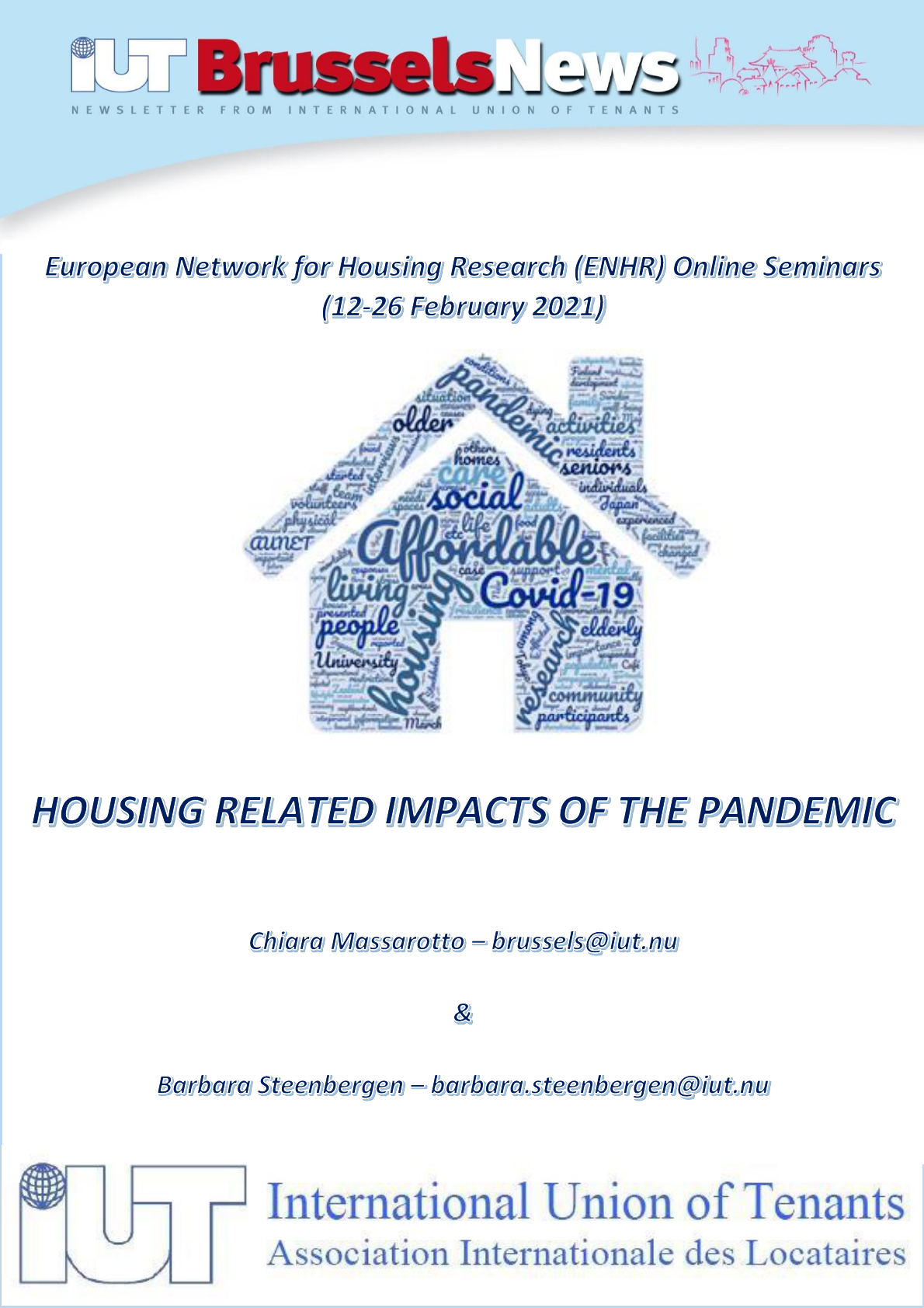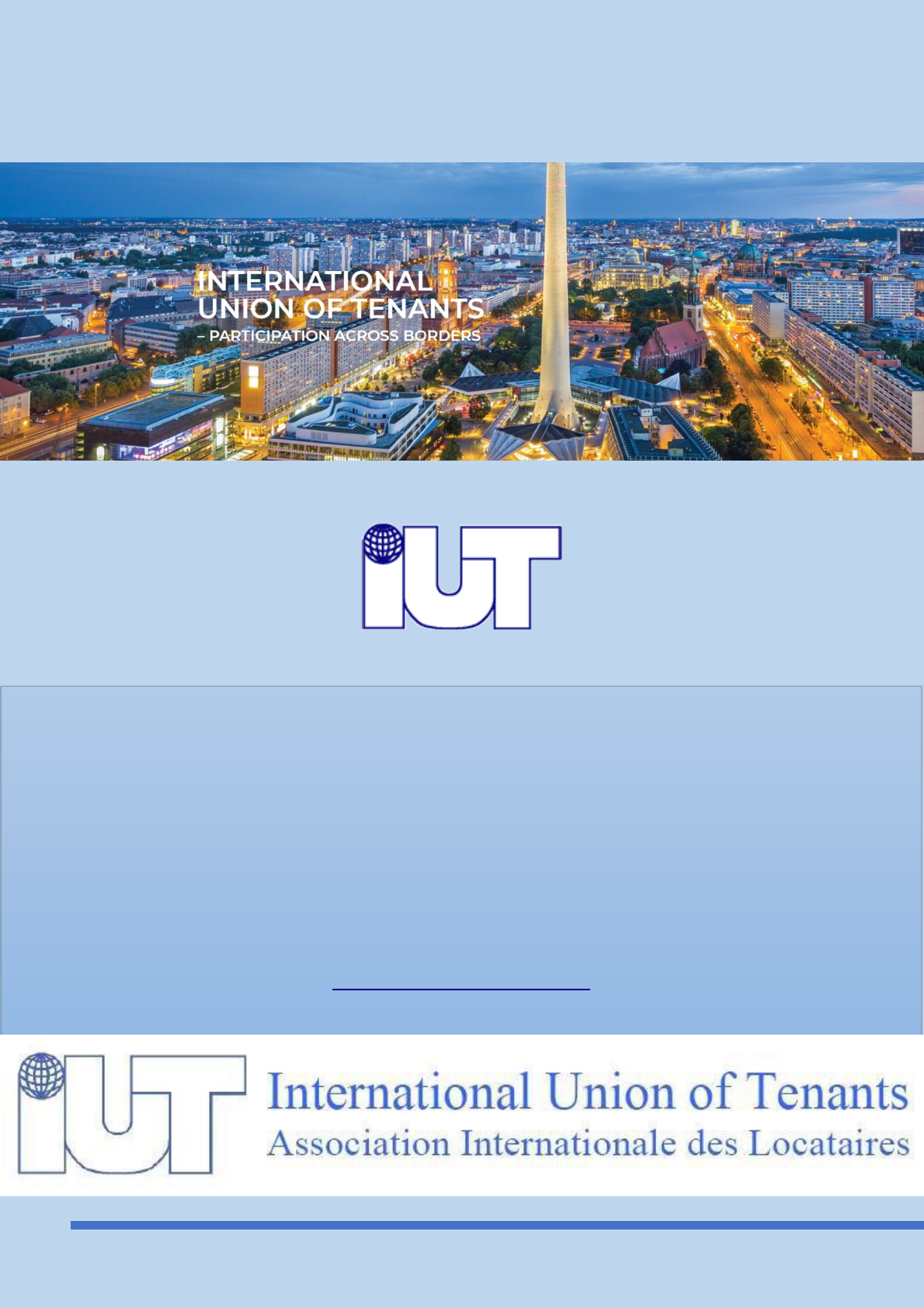

IUT BRUSSELS;ENHR SEMINARS ”HOUSING RELATED IMPACTS OF
THE PANDEMIC”
2
INDEX:
- European Network for housing research (ENHR) seminars “Housing
related impacts of the pandemic” – Opening Session ........................ 3
- Effects of Covid-19 on metropolitan housing and land markets ...... 7
- Multiple-property investment in times of Covid-19 ....................... 13
- Changing spatial preferences through Covid-19 ............................ 16
- The Covid-19 pandemic effects on housing and policy & research
responses ......................................................................................... 21
- The consequences of Covid-19 for sustainable communities and
housing ............................................................................................. 25
- How Covid-19 has affected older adults and their housing
conditions ......................................................................................... 30
- COVID-19 and Housing in Southern Europe ................................... 35

IUT BRUSSELS;ENHR SEMINARS ”HOUSING RELATED IMPACTS OF
THE PANDEMIC”
3
12
th
of February 2021
♦♦♦ ENHR seminars “Housing related impacts of the pandemic” ♦♦♦ The importance of
the EP resolution on decent and affordable housing for all ♦♦♦ The pandemic and
housing precarity in the U.S., Latin America and the Caribbean ♦♦♦The community
question in post-pandemic cities♦♦♦
European Network for housing
research (ENHR) seminars “Housing
related impacts of the pandemic”
1
–
Opening Session
On the 12
th
of February 2021, ENHR held the
opening seminar of a series of webinar under
the title “Housing related impacts of the
pandemic”, which took place online from the
12
th
until the 26
th
of February.
The seminar was divided into two roundtables,
one between ENHR housing experts –
moderated by Iván Tosics (Metropolitan
Research Institute, Budapest, ENHR vice-chair)
– and the other one between ENHR-related
networks, moderated by Montserrat Pareja-
Eastaway (University of Barcelona, ENHR vice-
chair).
Covid-19 as a game
changer for national
housing systems?
Prof. Peter Boelhouwer,
Technical university of Delft
(NL) and chair of ENHR, opened
the roundtable with a
presentation about the
possible effects of the
pandemic on the housing
market. Some of the short-term consequences
of Covid-19 are already visible: increase in
domestic violence, health issues (including
psychic problems), conflicts in public space,
drop in school performances, growing
unemployment rates, lower incomes and
1
https://enhr.net/online-seminars/
decrease in investments in multiple properties.
Indeed, there has been more awareness over
the need of adequate accommodation, and the
demand for social and affordable housing has
significantly risen.
In the long run, the consequences may include
additional difficulties in obtaining a mortgage
lending, more willingness of people to spend a
larger part of their income on housing,
attempts to create better working conditions
at home (since houses may be used as offices
even after the pandemic), arrears in education
affecting unprivileged children, further
economic difficulties for vulnerable categories.
Thus, a higher need of social and affordable
housing supply is expected.
A related question is whether cities are
becoming more or less popular because of the
pandemic, and the patterns indicate that it is
still unclear. On the one hand, figures show
that people are looking for housing with more
outdoor spaces and, since they no longer need
to live close to the office, they may prefer
moving outside of the city. On the other hand,
the need for contact, amenities and services
will grow, boosting the popularity of cities.
Professor Boelhouwer finally showed that in
the Netherlands, people in cities are less
satisfied since the spread of Covid-19 and the
trend of less citizens moving to the biggest
cities, preferring other parts of the Country,
outside of the Randstad area.
Peter Boelhouwer, Delft
University of Technology and
chair of ENHR

IUT BRUSSELS;ENHR SEMINARS ”HOUSING RELATED IMPACTS OF
THE PANDEMIC”
4
The importance of the
European Parliament
resolution on decent and
affordable housing for all
The roundtable continued with
the speech of MEP Kim van
Sparrentak, who highlighted
the relevance of the EP
resolution “Access of decent
and affordable housing”
2
,
approved on the 21st of January 2021. In fact,
there is an increasing number of people who
are struggling for the rising costs of housing
and it has been estimated that one in ten
Europeans spends 40% of their income on
housing. The level of homelessness has
doubled in the last decade and this crisis is
affecting every category. Even if housing is not
a European competence, the EU has
unconsciously approved many regulations
which negatively affect the housing market
and its affordability. The report gave signal that
EU needs to develop a social and affordable
housing strategy, to tackle homlessness, to
have equal access to housing markets and to
have climate-friendly houses. Indeed, the
European Parliament expects the Commission
to implement soon an integrated strategy on
this.
The report underlines the need of tenant
protection by security of tenure and by long
term rental contracts as default option instead
of gentrification and displacement as well as
rent price stabilization where required and
clear national rental regulations instead of
skyrocketing rent hikes and rack-rents by
further market liberalisation.
3
It calls to end homelessness by 2030, which is
becoming a crucial social problem. It will be
2
https://www.europarl.europa.eu/doceo/docume
nt/TA-9-2021-0020_EN.html
3
https://www.iut.nu/eu/ep-vote-on-affordable-
addressed in the Commission’s Action Plan on
the European Pillar on Social Rights and in the
Social summit taking place in Porto on the 7
th
of May 2021.
4
Furthermore, the report calls for increasing
investment in affordable housing - both from
Member States and the EU – and for more
housing renovation towards a green transition.
In this regard, energy plans should be
implemented immediately, in order to
ameliorate the living conditions, reduce the
energy bills and tackle both the climate and
housing crisis.
The report also raises the issue of illegal short-
term rental and the consequent lack of housing
availability for citizens in touristic areas.
Finally, it states that housing should be treated
as a fundamental right, while it is mostly seen
as a commodity. It is important to research
more on EU rules on transparency in real
estate transactions to avoid tax evasion and
money laundering and to have more clarity on
who actually owns the properties- the
beneficial owner.
A journalist’s
perspective: can we
collaborate on housing
from the transnational
perspective?
The first roundtable was closed
with the presentation of the
journalist José Calatayud, who
explained that the pandemic
has increased the media coverage on housing,
highlighting problems such as the lack of
internet, water, space, etc. He urged a tighter
collaboration on housing issues from the
transnational and interdisciplinary
perspective, which is possible thanks to the
housing-wins-the-day/
4
https://www.2021portugal.eu/en/porto-social-
summit/
José Miguel Calatayud,
journalist and Housing
Project director
Kim van Sparrentak,
Member of the European
Parliament

IUT BRUSSELS;ENHR SEMINARS ”HOUSING RELATED IMPACTS OF
THE PANDEMIC”
5
increasing availability of data. In fact, data are
crucial because they allow to cooperate across
borders and to compare the same situation in
different Countries.
José Calatayud is the director of Housing
Project at Arena for Journalism in Europe
which is an open network for journalists and
researchers working on housing issues. It
offers a newsletter and covers different topics
through policy papers, data, reports, etc. It is
collecting data and mapping them accordingly,
showing the potential and the challenges of
cooperating on these issues.
The pandemic and
housing precarity in the
U.S.
The second roundtable of this
opening webinar wanted to
give a perspective from outside
Europe, notably from the US,
Asia, and Latin America. Ed
Goetz was the first to take the
floor in this second part of the
seminar, explaining that US was facing a
housing crisis and precarity even before the
pandemic, which, of course, is worsening the
situation. Poverty is indeed increasing, and
more people are forced to move in with others,
using spare rooms or couches, thus affecting
the quality of life.
In the US, housing precarity is largely defined
by race, ethnicity, and gender. Black and
Hispanic people in particular suffer from higher
eviction rates, risk of displacement,
discrimination, instability, and poverty. The
pandemic has widened these gaps, and, in fact,
it has been demonstrated that especially
vulnerable groups are facing higher risks of
infection and mortality, job loss, instability and
eviction. Inequalities and discriminations are
strongly growing, while the US real estate
market is booming.
The policy responses have been uneven and
include:
- eviction/foreclosure moratoria: temporary
attempts to keep people in their homes
enacted by the federal and local governments,
which just postpones evictions, since it does
not provide financial support to people unable
to pay their rents.
- emergency rental assistance: subsidies to
people in difficulties, but really limited in its
implementation.
- transitional/emergency housing: different US
governments have purchased old hotels in
order to convert them into transitional
accommodation or social houses.
- utility payment assistance/shut off moratoria.
Usually these policies are local-based, rather
than state-driven.
The community question
in post-pandemic cities
The second speech was held by
professor He, who explained
that the four major challenges
to face in the replanning and
governing of the post-
pandemic cities will be:
mobility, livability, security and
sociability. All of these aspects
are connected with socio-spatial relations and
processes at multiple scales. She asserted that
a more comprehensive planning and
governance considerations going beyond the
modernist approaches are needed. Thus it is
important to take action on the four key
challenges stated above. Mobility tends to be
a privilaged asset, which, when poorly
developed, leads to the retreat to the
neighbourhood and home space. Mobility
should be accessible for all and should be
further advanced in post-pandemic cities.
Moreover, since home and neighbourhood are
now central nodes of the urban life, planning
should create 15-minute cities, where all the
Ed Goetz, Humphrey School of
Public Affairs, University of
Minnesota and chair of Urban
Affairs Association
Shenjing He, University of
Hong Kong, and vice-
chairman of APNHR

IUT BRUSSELS;ENHR SEMINARS ”HOUSING RELATED IMPACTS OF
THE PANDEMIC”
6
daily needs can be reached by the citizens
within a short walk or bicycle ride from home –
thus increasing livability. From the security
point of view, instead, it would be optimal to
have “pandemic-proof” key infrastructure and
communities, using smart technology for
surveillance purposes. This, however, rises
privacy issues that cannot be ignored. Thus, in
the post-pandemic cities, a new and better
balance should be found. Finally, sociability will
be a crucial aspect in the cities, which will have
to find a way to compromise between social
proximity and social distancing, providing
social support to families, workplaces and
communities.
The residential community will thus regain its
centrality in the post-pandemic city, being
crucial for providing mobility, livability,
security and sociability. Covid-19 is causing
complex outcomes at the community level,
often leading to a trade-off between security
and sociability, livability or mobility. For these
reasons, we need long-term recovery plans to
reduce inequality and segregation at the
community level. An increase in investment in
community-based organizations and facilities
is necessary, especially for providing
affordable housing and socio-economic
opportunities for the unprivilaged categories.
Housing policies and
informal settlements in
Latin America and the
Caribbean
The second roundtable was
finalized by Anaclaudia
Rossbach, who opened her
speech explaining that Latin
America is the most unequal and violent region
in the world, where Covid-19 affected millions
of people and where the migration scenario is
very dynamic. In fact, many migrants are
moving within the region, increasing the
pressure for housing. Moreover, the GDP
decrease – which started before the pandemic
– is accelerating and now more than 20% of the
population lives in precariousness.
In terms of housing, homelessness and poverty
visibly increased during the pandemic and
informal settings expanded. Empty buildings
are now informally occupied by thousands of
people no longer able to pay their rent. The
Forum for housing in Latin America tried to
facilitate a political dialogue in Colombia in this
regard, obtaining a moratorium in evictions –
also for informal settlements – and some cash
transfer programs. In Chile, instead, rental
voucher programs were reviewed, and
subsidies were expanded. In Mexico, a new
land policy was launched, stating the right to
not be evicted and increasing the budget for
the upgrade of informal settlements and for
the construction of social houses. In Central
America, instead, the focus has been on the
furniture of water and basic services.
In a final exchange of views between the
participants, it emerged that all around the
globe the main actions in the housing sector
have been taken by the communities and the
cities, rather than by States. But since the local
governments face several budget constraints,
States should be more present in providing
fiscal resources, subsidies, and good
legislation.
It seems like Covid-19 has not really created a
new crisis, but it has exacerbated the existing
ones, creating higher urgency to tackle them.
New policies are now being implemented and
need monitoring. It is thus important to
continue fighting for equality and dignity of
communities and for an open, accessible and
affordable housing sector.
Anacláudia Rossbach, Cities
Alliance – Latin America
and Caribbean

IUT BRUSSELS;ENHR SEMINARS ”HOUSING RELATED IMPACTS OF
THE PANDEMIC”
7
15
th
of February 2021
♦♦♦ Effects of Covid-19 on metropolitan housing and land markets ♦♦♦
Research ideas and reflections from the attendees ♦♦♦ Is there a new urban
model needed? ♦♦♦
Effects of Covid-19 on metropolitan
housing and land markets
On the 15th of February 2021, two ENHR
Working Groups (WG Metropolitan Dynamics:
Urban Change, Markets and Governance
5
; and
WG Land Markets and Housing Policy
6
) held a
joint online workshop as part of the ongoing
ENHR seminar series, with the following aims:
to explore the spatial effects of the
COVID-19 crisis regarding land and
housing markets, connected to
changes in mobility forms, workplace
locations and home office tendencies.
to analyse the potential tools for the
public sector to steer the future
development of metropolitan areas.
The WG Metropolitan Dynamics: Urban
Change, Markets and Governance was
established in 2005 on the belief that the
spatial dimension of housing never stops at the
city borders but affects all the urban and
metropolitan areas. Here, housing can be
considered as a means to develop solutions to
urban (densification, suburbanization, urban
sprawl), social (affordability, homelessness,
segregation) and environmental (energy
provision, green areas) problems. This WG is
5
https://enhr.net/metropolitan-dynamics-urban-
change-markets-and-governance/
thus interested in the operation of local
housing markets in the functional urban area,
notably in the territories around the core city.
The objective of this WG is strengthening the
metropolitan aspect, whose relevance has
increased during the current pandemic.
The WG Land Markets and Housing Policy,
instead, is almost 10 years-old and it has
widened its scope during the years. It now
focuses on the consequences of planning and
policymaking on the supply of land for
different types of housing.
Covid-19 is certainly affecting the metropolitan
housing and land market, among many other
sectors of human life. Many urban residents
are looking for bigger houses with some
open/green areas (balcony, terrace or garden).
A trend to a new suburban wave is expected in
many cities and, since people may
permanently work from home, they may
prefer to live outside of the city centre and
travel longer distances the few times they
need to reach the office.
It is also possible that people will prefer to
move by car, rather than by public transports,
changing the urban landscape.
Finally, the pandemic is increasing the social
awareness on the value of urban greens,
agriculture, bicycle lines and other measures
for safe and inclusive urban outdoor spaces.
The participants of the seminar had the
possibility to present their research ideas,
6
https://enhr.net/land-markets-and-housing-policy/

IUT BRUSSELS;ENHR SEMINARS ”HOUSING RELATED IMPACTS OF
THE PANDEMIC”
8
aiming to discuss potential topics in view of a
possible joint Workshop in the next ENHR
Conference in Nicosia
7
, taking place from the
30
th
of August until the 2
nd
of September 2021.
Effects of Covid-19 in the
Metropolitan Area of
Tirana-Durres
Artan Kacani and Valerio
Perna (both from Polis
University, Tirana) were the first ones to
present their research ideas, which focused on
the Metropolitan area of Tirana-Durres. Here,
during the last 30 years, the urban system has
expanded from 3% of the Regional surface, to
9%, but 2/3 of the urban land has no land
tenure.
The municipality of Tirana has adopted a
Master Plan for the city, which, since the
lockdown, has led to mass evictions and police
brutality, aiming at eliminating all forms of
informal dwellings from the development
sites. Moreover, building permission has been
centralized in the hands of the government
with a “e-permission” platform, against the
European Charter of Local Self-Government
8
.
In Albania, Covid-19 has led to a decrease in
employment, GDP, investments, and net
exports. The housing market is dominated by
foreigners, since many people (especially from
Italy, Spain, and US) come to Albania to enjoy
their pension, forcing native people to move to
the suburban areas, where there is a lack of
basic services. Covid-19 has worsened the
situation and the process of gentrification.
Furthermore, during the lockdown, mobility
was reduced, and many workplaces were
inaccessible and now that urban transports
fully work, there are no anti-Covid rules
applied, causing increases in infection rates.
The challenge now is avoiding urban sprawl
while maintaining less densely populated
7
https://cyprusconferences.org/enhr2021/
8
https://www.coe.int/en/web/conventions/full-list/-
areas. Planners should focus on the
inhabitants’ needs and on the peripheric areas
as resources for the city rather than a
hindering factor.
All these issues will be addressed during the
Tirana Design Week
9
, taking place from the
27th of September until the 10th of October
2021.
Covid-19 impact on
housing construction
activity: the case of
Łódź (Poland)
Magdalena Zaleczna (University of Łódź)
researched whether a shift in construction
from inside to outside of the city or a shift in
the city border is already visible or not.
The macro situation in Poland is not too bad
and the trends suggest that housing prices are
rising, while rent prices are decreasing.
Housing construction is increasing, suggesting
that people are optimistic about the future. In
Poland there are two main groups in housing
construction: individuals and developers. The
latter are more active now and create new
supplies in big cities, where, however, the
permissions to build are decreasing.
Magdalena Zaleczna showed that there is not
a shift from big cities to small cities when
comparing permissions to build and that there
are no big differences in construction actions
before and after the pandemic.
Her research concluded that:
- the activity of individuals preparing for
housing construction in Łódź increased in 2020
- the activity of developers reduced in Łódź;
- there was no significant change in the new
housing projects issued by individuals in Łódź;
- developers significantly reduced the number
of started investments in Łódź;
- in all the above-mentioned trends, the data
/conventions/treaty/122
9
https://tiranadesignweek.com/

IUT BRUSSELS;ENHR SEMINARS ”HOUSING RELATED IMPACTS OF
THE PANDEMIC”
9
collected in the neighbouring counties show
both increases and decreases.
Probably people in Poland have started buying
land instead of dwellings, but this trend still
needs to be confirmed.
Post pandemic
planning for UK
housing market
Glen Bramley (professor
of Urban Studies at
Heriot Watt University, Edinburgh) explained
that Covid-19 caused a deep economic and
sanitary impact on UK. Government
incompetence and corruption have worsened
the situation, although some issues – such as
vaccines – were handled well. Moreover,
Brexit is likely to exacerbate the economic
problems. However, the pandemic also
showed that governments spend far more than
they usually admit to.
The increase in homeworking and the concerns
about crowded environments and public
transports may lead to a collapse of the
strategies based on city centre intensification
and a consequent boom in counter-
urbanization strategies, pressuring rural
markets and promoting more car-dependence.
The shifts towards the online retail may cause
a conversion of the shops into houses or
opportunities for local and small businesses.
Moreover, many buildings are still made of
unsafe materials and the legacy of Grenfell
Tower fire is still unsolved.
The UK government is trying to reform its
planning system towards a zoning strategy,
increasing housing supply through the
imposition of housing number targets.
However, there are no commitments for new
social housing.
Strategic planning in London city
region – the impacts of Covid-19
The research idea of Duncan Bowie (professor
at Westminster University) was focused on the
impacts of the pandemic on the London city
Region and the Wider South East.
London’s Strategic Planning started five years
ago, and the New London Plan is about to be
published, after major disputes between the
mayor and the central government. However,
there is no strategic planning for the wider
London Region. The planning network tends to
argue for a polycentric approach, suburbs
intensification, more residential and
employment growth in the cities around
London, but insufficient family houses have
been built.
The three new factors to keep in mind are
Brexit, Covid-19, and the cladding scandal that
followed the Grenfell Tower fire. All these
aspects have worsened the situation of the
regional housing market and economy. In
particular, the pandemic has highlighted the
importance of internal and external spaces
and, because of homeworking, many offices
could be converted into residential houses.
Covid-19 has also caused a decline of central
London cultural facilities, making it a less
attractive place to live in. There may also be a
change in high streets, replaced by online
shopping, and public transports will need to be
subsidized more.
Duncan Bowie concluded that it is necessary to
rethink the approach to spatial planning and
focus more on family-sized homes and open
spaces. The case for suburban intensification
and a more polycentric approach to planning
and development is now evident. Moreover,
the assumptions about population and
employment growth should be revisited
according to the less certain future. Finally,
there is the need for a more effective
governance and strategic planning for the

IUT BRUSSELS;ENHR SEMINARS ”HOUSING RELATED IMPACTS OF
THE PANDEMIC”
10
London City Region, also focusing on the wider
South East.
Post-Covid housing supply
Constance Uyttebrouck (from University of
Liège) presented her research idea on the
housing supply after the pandemic, studying
changes in residential preferences, new forms
of live-work housing and adapted built
environments in Brussels.
The relationship with houses has indeed
changed during the last months, since people
are willing to adapt their houses for
homeworking. Her research will be based on
four hypotheses:
1. forced telework will lead to changes in
working conditions, residential preferences
and cities ‘attractiveness;
2. changes in preferences and needs will cause
a reconfiguration of housing;
3. the new sanitary context will lead to an
adaptation of working amenities;
4. Covid-19 crisis will cause a faster response
from the market than the one from the
governments, especially in liberal housing
regimes like in Brussels.
Her research goals are: understanding changes
in residential preferences and housing needs,
exploring possible responses from the supply
side, elaborating explorative scenarios and
providing policy recommendations.
The research will be implemented in three
phases and should last three to four years,
depending on the available financing, and the
expected outcome is the delivery of policy
recommendations.
The Pandemic Wild Card
in Planning – the case of
Iceland
Sigríður Kristjánsdóttir (from
Agricultural University of
Iceland) presented her
research on the housing
market in Iceland, which has not been too
much affected by the pandemic. The interest
rates for housing have been lowered, which
convinced many people to buy apartments.
Most of the dwellings are available downtown
in old buildings, where the demand is low, and
the price is lower in the city centre than in the
suburban areas. Many apartments previously
rented through Airbnb are for sale and most of
the new buildings are thought for hotels.
Many people are buying houses outside of
Reykjavik because with the same price they get
a bigger and fancier house.
Iceland needs to rethink its planning and its
mobility strategies. A new rapid transport
system in Reykjavik has just been launched,
but it is a bad timing, since people are moving
outside of the city and travel more by car.
The post-Covid 19 city: Reawakening
urban communities?
Berit Irene Nordahl (from Norwegian
University of Life Sciences) did not present a
research, but some reflections on the ongoing
situation in Norway. The final outcome of the
pandemic is still to experience, but so far Oslo
was poorly affected by it. Here, the real estate
market prices are growing. There has been an
elaborated and widely shared policy of
compact growth both in metropolitan cities
and in regional centres. Even with
homeworking, there is still strong support for
urban living, also in regional towns.
With the lockdown, from one day to another,
the city became empty: no cars, tourists, or
spending. People could enjoy urban outdoors

IUT BRUSSELS;ENHR SEMINARS ”HOUSING RELATED IMPACTS OF
THE PANDEMIC”
11
as if they were in their own gardens. Citizens
refused to let commercial interests take over
their spaces and insisted on urban outdoors.
Moreover, since it was not possible to travel
abroad, people started to enjoy more their city
and to take better care of their urban
community. Urban planning should thus focus
on delivering good everyday life environment
to citizens.
She is optimistic about the future and does not
expect people to move away from the city
centre after the pandemic. Possible research
questions might be how to bring new
experience onboard in urban maintenance,
upgrading and care, urban transformation and
cities ‘attractiveness.
The case of Budapest
metropolitan area
Janos Balazs Kocsis (from
Corvinus University of
Budapest) shortly presented
the situation in the Budapest
metropolitan area, which was changing also
before the pandemic. According to him it is too
premature to state something solid on the
consequences of the pandemic and he is
sceptical about possible general changes.
Surely there will be some sort of changes,
especially related to white collar jobs that
could be carried out at home. However, many
other activities require special proximity to the
offices.
He expected more shifts in terms of activities
towards the periphery of the city of Budapest.
The impact of COVID19 on the
dream futures of the youth
Willem Korthals (from TU Delft)
presented the RURALIZATION
10
theory, according to which, facilitating
rural newcomers and providing access
to land can create more opportunities for new
10
https://ruralization.eu/
generations. More young people would move
in and less would move out of the Country,
creating a relative younger and renewed
population, thus allowing more economic
activities.
RURALIZATION held different workshops with
young people in different European Countries,
asking them about their livelihood recipe,
accommodation and lifestyle recipe and the
obstacles they face. Then they asked them
about their dream place of residence and data
show that the majority of participants would
like to live in rural areas close to the city (30%),
in an area outside of the city centre (21%) or in
a rural village (17%). Only 10% would like to
live in the city centre, 13% in a suburb in a city
area and 9% in a remote rural area.
30% of the respondents reported that the
pandemic changed their future dreams, and
this was especially true for young people
wishing to live in urban areas. However,
obstacles in realizing a specific dream were
more common than changes in the contents of
the dream itself.
The theory shows that the pandemic has led to
a re-evaluation of personal values and
preferences towards a rural-based
perspective.
The next step of this project led by
RURALIZATION will be a discussion with
stakeholders in 20 regions.
At the end of Korthals’ speech, however, Ivan
Tosics (ENHR vice chair) argued that there are
always less rural areas close to the cities and
that the closer the area to a city, the less it is
rural.

IUT BRUSSELS;ENHR SEMINARS ”HOUSING RELATED IMPACTS OF
THE PANDEMIC”
12
Instant shifts in the
metropolitan area in the
pandemic centre vs
periphery – the case of
Thessaloniki
The last presentation was held by Charikleia
Christodoulou (from the Research Unit for
South European cities). There was a research
program on social housing in Thessaloniki, but
the pandemic obstructed it.
In this area there is a lack of metropolitan
planning and deregulation after the successive
“Economic Adjustment Programs” of the
European Commission, The European Central
Bank and the International Monetary Fund and
impositions by the Greek governments since
2010.
The housing market demand was
characterized by high rents and with a shift of
the residential market from rented housing to
short-term tourist accommodation and
gentrification of central areas. Thus, there has
been an intersection of policies that came from
top-down governmental directives in the
sector of tourism, housing, and small-medium
enterprises retail & services. During the
pandemic they assisted to waves of change
and to sudden shifts in small-scale property
management in relation to these three sectors.
In fact, there has been an immediate and
spontaneous shift from short-term/Airbnb
solutions to rental housing.
Moreover, during the second wave of Covid 19
many students were sent back home, leaving
many dwellings empty.
Now the issue of long-term planning in Greek
cities arises again because new urban routines
and public regulations emerged, changing the
structure of the metropolitan area function.
Is there a new urban model needed?
Ivan Tosics (ENHR vice chair) closed the
seminar with a final remark, quoting the OECD,
which stated that “It is not density alone that
makes cities vulnerable to COVID-19, but the
structural economic and social conditions that
make it possible or difficult for cities to take
suitable measures against the spread of the
virus. Cities that are characterized by
inequality, poor living conditions and the
spatial concentration of poor sections of the
population are far more vulnerable than the
wealthy”.
In a potential paper for the ENHR Nicosia
Conference, he would like to find out what
local governments can do in this situation and
how the public sector in general can react.
Urban areas should not be already written off
and it would also be good to research the
effect of outmoving, since rural areas are likely
to become urban areas.

IUT BRUSSELS;ENHR SEMINARS ”HOUSING RELATED IMPACTS OF
THE PANDEMIC”
13
15
th
of February 2021
♦♦♦ Multiple-property investment in times of Covid-19♦♦♦ The total return and risk
to residential real estate ♦♦♦ Housing crisis and the future of Residential real Estate
Investment Trusts (REITs) ♦♦♦ Inside the world of middle-class Hong Kong
transnational property investors ♦♦♦ Resurgent Landlordism in a Student City
♦♦♦ Airbnb in Berlin and Amsterdam, before and during the Covid-19 pandemic
♦♦♦ Short-term Rentals, Housing markets and Covid-19♦♦♦
Multiple-property investment in
times of Covid-19
On the 15
th
of February, Christian Lennartz
(PBL Netherlands Environmental Assessment
Agency), Justin Kadi (Assistant professor,
Faculty of Spatial Planning, Vienna University
of Technology) and Cody Hochstenbach
(Postdoctoral researcher, Urban
Geography, Universiteit van Amsterdam)
moderated the workshop ”Multiple-property
investment in times of Covid-19”, which was
part of the ENHR seminars on the housing
related impacts of the pandemic. However, it
has not been organized by a specific ENHR
working group.
The workshop included six presentations and
counted 20 participants.
The focus of this seminar was on landlordism
11
in the private rental and housing sector,
investments into tourist accommodation and
second homes and how they were (or will be)
affected by the pandemic.
11
the practice under which privately owned
property is leased or rented to others for
occupancy or cultivation.
There is a lot of evidence that Covid-19 has a
negative impact on landlordism and returns of
investment in landlordism. In fact, rents’ prices
are going down in San Francisco, London, New
York, Amsterdam, Munich, and other big
European cities, since demand went down
during the pandemic.
The total return and risk to
Residential Real estate –
Matthijs Korevaar
Matthijs Korevaar (Erasmus
School of Economics) recently
published a paper
12
on “The
Total Return and Risk to Residential Real
Estate”, analysing how much return landlords
make out of their investments in the rental
market.
In his presentation, he also made a connection
to Covid-19, looking at pandemics in the past
and how landlords behaved. He found out that
throughout the history of the private rental
sector, pandemics did not have strong impacts
on rents, but had short impacts on house
prices. Right now, he sees a reverse trend:
rents are going down while houses’ prices are
stable.
12
https://papers.ssrn.com/sol3/papers.cfm?abstract_
id=3549278

IUT BRUSSELS;ENHR SEMINARS ”HOUSING RELATED IMPACTS OF
THE PANDEMIC”
14
In Real estate we trust? Covid-
19, Housing crisis and the future
of Residential Real Estate
Investment Trusts (REITs) – Zac
Taylor
In his presentation, Zac Taylor (KU Leuven)
focused on how Residential Real Estate
Investment Trusts (REITs) became a bigger
player in the European and American rental
market context and how they behaved during
the pandemic.
After a short period of hesitation, it may be
expected that investors will pick up the assets
they had before the pandemic because they
have long term investments horizons, so they
would not like to change their investment
plans. However, now there is a shifting away
from prime urban housing market of investors
focusing on suburban housing markets. The
trends seem to shift from multifamily
apartment buildings in the city centre, to single
family apartments in suburban environments.
Inside the world of middle-
class Hong Kong
transnational property
investors – Hang Kei Ho
Hang Kei Ho (University of Helsinki) focused on
international investments’ behaviour in Hong
Kong, in particular towards the London
housing market. He presented his paper Inside
the world of middle-class Hong Kong
transnational property investors: ‘5980 miles
to my second home’
13
and also stressed the
importance of not concentrating only on the
13
https://www.tandfonline.com/doi/full/10.1080/19
491247.2019.1611364
pandemic. In fact, there also other turbulent
events happening, especially in Hong Kong,
where the Chinese authority is increasing. This
is leading many citizens in Hong Kong to
increase their international investments since
they perceive their assets to be more unsafe
due to the political context.
Resurgent Landlordism in
a Student City – Cody
Hochstenbach
Cody Hochstenbach
(University of Amsterdam)
presented his paper Resurgent
landlordism in a student city: urban dynamics
of private rental growth
14
. In his research, he
studied different types of landlords and how
they invested in Groningen (The Netherlands),
which is a medium-sized university city. Small-
scale private landlords still dominate the
market, but there is a trend shifting towards
property concentration. It is also important to
understand the different categories of
landlords, since they show different
investment strategies.
14
https://www.tandfonline.com/doi/full/10.1080/02
723638.2020.1741974

IUT BRUSSELS;ENHR SEMINARS ”HOUSING RELATED IMPACTS OF
THE PANDEMIC”
15
Airbnb in Berlin and
Amsterdam, before and
during the Covid-19
pandemic – Jelke Bosma
Jelke Bosma (University of
Amsterdam) shortly presented
his PhD research on Airbnb investments in
Berlin and Amsterdam and how behaviours are
changing due to Covid-19. In fact, the
pandemic has severely affected the tourism
sector and Airbnb Rentals have sharply
decreased in the last years. Hosts are thus
looking for other ways to rent out their
properties, especially those who rely and
depend on this income.
He also published an article on this topic
15
.
Short-term Rentals, Housing
markets and Covid-19 –
Justin Kadi
Justin Kadi (Vienna University of
Technology) had a short
presentation on the Short-Term
Rental Market and Covid-19, witnessing the
case of Vienna (Austria). Here, many Airbnb
properties were taken out for the Short-Term
Rental Market (since there was almost no
demand in 2020) and were offered in the
Common Rental market, without affecting
rental prices yet. However, since the
timeframe of his research might be not long
enough, this trend still has to be confirmed.
15
https://platformlabor.net/blog/airbnb-and-covid- 19-capturing-the-value-of-the-crisis

IUT BRUSSELS;ENHR SEMINARS ”HOUSING RELATED IMPACTS OF
THE PANDEMIC”
16
17th of February 2021
♦♦♦ Changing spatial preferences through Covid-19, ♦♦♦ Covid-19 effects in the
Netherlands ♦♦♦ The UK context ♦♦♦ Changes in housing preferences and group
communication practices ♦♦♦ Danish survey on housing ♦♦♦ Sharing a home
during lockdown ♦♦♦
Changing spatial preferences
through Covid-19
Covid-19 is deeply affecting our lives and our
economies. People are changing preferences
very rapidly and the housing market seems to
adapt to them. This seminar was organized
with the aim of researching the change in
people’s spatial preferences. Will working from
home remain the standard? Will the already
migration flows towards the sub-urban areas
continue? Or will the city centre regain its
attractivity? Participants tried to answer these
questions showing facts and figures about
their national housing market.
Covid-19 effects in the
Netherlands
Prof. Peter Boelhouwer (ENHR
chair) presented the situation in
the Dutch housing market,
explaining that the impact on
trust indicators after the 2008
financial crisis was much higher than today’s.
However, the housing market is clearly
unbalanced now. Prices in the rental market,
after constantly increasing since 2012, slightly
decreased in the last quarter, possibly because
of the pandemic that forced many expats to
return to their home Countries. Building
permits started decreasing sharply two years
ago, leading to an important shortage of
dwellings. Even before Covid-19, people
16
https://www4.shu.ac.uk/research/cresr/
showed preferences for living in sub-urban
areas and every year more people are moving
away from the four biggest cities (The Hague,
Amsterdam, Utrecht, and Rotterdam),
probably because of the lack of social and
affordable houses there. Nowadays, this trend
seems increasing, since people living in cities
are less satisfied with their home than people
living outside of the cities. 10% of home
seekers stipulate that the pandemic changed
their housing demand. In fact, the demand for
houses with gardens increased by 19% and
with outdoor spaces by 18%. There is now
more demand for houses (8%), and less for
apartments (-12%).
It is still early to state if cities are becoming less
or more popular. On the one hand, people are
now showing their strong preferences for
houses with outdoor spaces and gardens in
sub-urban areas and would like to have
separate zones for working and living at home.
On the other hand, the need for social contact,
amenities and services will grow, perhaps
making cities more popular again.
The UK context
Ed Ferrari (Centre for
Regional Economic and
Social Research
16
)
explained that the place
policy ‘landscape’ in the
UK before Covid-19 was defined by Brexit, the
climate emergency (need to find a more

IUT BRUSSELS;ENHR SEMINARS ”HOUSING RELATED IMPACTS OF
THE PANDEMIC”
17
sustainable urban model), the Productivity
Puzzle (need to close big regional productivity
gaps) and widening social and health
inequalities.
The problems of stimulating housing supply
and dealing with market failures in the private
rental sectors are now broadly accepted and
understood after the pandemic. In particular,
Covid-19 caused profound economic changes
and unemployment, brought new risk factors,
and led to the reconfiguration of social
relations and capital. All of these aspects have
explicit housing market impacts.
The number of people asking for social support
has increased, especially in Birmingham and
London, less significantly in smaller cities. In
fact, Covid-19 has turned the map of “city
centre vitality” inside-out: larger cities are now
the ones with the lowest footfall (number of
people entering a shop) and spending rates,
compared to smaller towns. This might be a
portent of the model of spatial structure to
come.
On the social relations and capital side,
through the pandemic digital divide,
neighbourliness, and the use of local facilities
increased significantly, making clear that the
“15-minute city” can be enjoyed only by
people that can really afford it.
In conclusion, after the pandemic, the location
will matter more than ever. The incipient trend
of “north shoring”
17
could be accelerated.
Finally, the post-Covid recovery will accentuate
differences between neighbourhoods, leading
to a widening of intra-urban inequalities.
17
the process of business and entrepreneurs moving
to northern cities in the UK in order to save
Urban housing markets in UK after the
pandemic
Nick Bailey (from the Urban Big Data Centre
18
)
presented an initial assessment of the short-
term impacts of Covid-19 on the private rental
sector, focusing on three city-regions:
Birmingham, Bristol, and Manchester.
The UK context is characterized by high
inequalities, a deregulated labour market and
a dualist rental system divided into a
substantial decommodified social rented
sector and a deregulated private rental sector.
He focused on the latter, which rapidly grew in
the last 30 years and houses a greater
proportion of younger and poorer households.
The rental market is dominated by the cities
and there is no evidence of downward shifts in
the urban hierarchy. As for the rent levels, the
upward trend has not stopped with the
pandemic. There is an increased demand for
more spacious houses and a higher willingness
to pay more than before the lockdown to
achieve it. However, this is observed only in
Birmingham and Bristol and not in Manchester.
Another interesting trend in these three cities,
is an increased willingness to pay more for
central living, meaning that people are not
willing to move outside of the city.
Even in the short term, the picture is really
complex and uneven between and within
cities. Further analysis is thus needed, notably
to explore local variations across city-regions,
changes in density, greenspace, etc. and to
money.
18
https://www.ubdc.ac.uk/

IUT BRUSSELS;ENHR SEMINARS ”HOUSING RELATED IMPACTS OF
THE PANDEMIC”
18
compare these trends with the house sales and
rental markets.
Changes in housing
preferences and group
communication practices
Pablo Garcia de Paredes (PhD at
Laval University, Quebec) is
researching on how the pandemic
is affecting our relationships to
digital tools, our home preferences, and our
group communication practices.
He is going to study two different types of
population: those with digital adaptation and
anthropological relation with digital tools, and
those who do not have access to digitalisation.
His study will include communication and
spatial variables and the home concept will be
treated both as a dependent and independent
variable. The study will also be based on two
categories: workers working from home and
workers who kept going to their workplaces,
focusing on changes in work environments
before and after Covid-19.
In his preliminary survey it emerged that
almost half of the people managed to adapt
their houses as their offices with medium
investment, trying to assign different areas of
the house to each person. More than half of
the participants stated that their home stress
level has gone up, but that they have
maintained their lifestyle despite the
Pandemic.
He concluded his presentation explaining that,
according to him, many ongoing changes will
not last, but different skillsets were born out of
the pandemic and they will remain.
Danish survey on housing
during the pandemic
Michael Harboe (Senior Analyst
at The Knowledge Centre for
Housing Economics) shortly
presented a survey conducted in
association with Statistics
Denmark, submitted to
approximately 1.000 Danish people during the
pandemic. The survey highlights the
expectations for house prices, considerations
around moving, the share of potential first-
time buyers, the share of young homeowners
considering an upgrade and considerations on
Covid-19.
The results show that spatial preferences are
shifting in Denmark in response to Covid-19.
Suburbs and towns seem to be more sought
after the pandemic. Many people are
interested in moving within five years,
especially apartment dwellers looking for
larger houses.
In Copenhagen there are little developments
and the percentage of people moving away
from the city is small. This is probably because,
according to the survey, the pandemic is
expected to be temporary, so people are not
taking purchasing decisions based on Covid-19.
Finally, the results show that real estate capital
gains are still expected to be larger in and
around Copenhagen.
Sharing a home during
lockdown
Kath Scanlon (from London School of
Economics) explained that sharing
with others or living with parents is the
norm for young Londoners and that
the number of single-person
households in younger age groups has fallen
for decades. These trends are driven by the
cost of market housing and the shortage of

IUT BRUSSELS;ENHR SEMINARS ”HOUSING RELATED IMPACTS OF
THE PANDEMIC”
19
social/affordable housing. Her research
focused on how shared homes perform
physically and as social spaces under lockdown
and the effect on housing aspirations of this
age cohort. The project was led in
collaboration with Pocket Living
19
, which is a
specialist provider of affordable homes for
London workers. They first submitted to
individuals on the Pocket homes registration
list an online survey in May-June 2020,
following the first strict lockdown. The
eligibility criteria for the survey were: live or
work in London, be non-homeowners and have
a household income lower than £90,000/year.
44% of the respondents shared their home
with unrelated people, 31% with partners, 17%
with parents and 62% rented from private
landlords. 70% were working full-time when
they completed the survey, 83% were working
from home and 69% said that some/all others
in the household were also working from
home.
Participants working from home rated the
shortage of suitable work surfaces as the
biggest challenge to overcome (46%), followed
by shortage of space (42%), inadequate Wi-Fi
(26%) and challenges presenting professionally
to colleagues or clients (21%). Moreover,
participants working at home while sharing,
stated that the biggest difficulties: noise (44%),
lack of privacy (43%), needing to use the same
room for work (37%), or the same work surface
(26%), incompatible daily routines/working
hours (24%) or interpersonal conflicts (18%). In
fact, tensions between frontline workers and
housemates working from home emerged
because of the fear of getting infected or
because of different working shifts.
The survey shows that lockdown has changed
housing aspiration. Participants stated to be
more motivated to save for home ownership
(22%), to be willing to prioritise outdoors space
in their next home (22%), to leave shared
19
https://www.pocketliving.com/
accommodation (20%), to leave London as
soon as possible (8%) and to prioritise living in
house rather in in a flat (8%). Participants also
showed their fear of having to share an
accommodation for longer (13%), of not
becoming homeowner (10%) and to not be
able to leave a shared accommodation (8%).
Recent projections say that the pandemic may
cause population to fall by 300,000 in London
and actual trends show that rents are falling
sharply for flats without garden in inner
London and are rising for houses with green
space.
Scanlon stated it would be interesting to see
how the questions and responses would differ
now, after one year of pandemic.
Final remarks
Christian Lennartz (PBL
Netherlands Environmental
Assessment Agency)
wrapped-up the session,
clarifying that the trust in
housing market is not shaking
as expected and that data point in different
directions across and within cities. Future
research will also have to focus on the Covid-
19 effects on specific economic sectors and its
consequences on the housing market.
The seminar was closed by a Q&A session,
during which Barbara Steenbergen (Head of
IUT Brussels office) raised awareness over the
conversion of offices into residential flats and
the importance of research on that topic.
Speakers from the UK explained that the
conversion of offices to residential dwellings
has been very problematic so far because of
difficult compliance with planning law and
space standards. Pablo Garcia de Paredes
instead, witnessed that many empty offices in
Panama, especially from the American

IUT BRUSSELS;ENHR SEMINARS ”HOUSING RELATED IMPACTS OF
THE PANDEMIC”
20
managed land, were given to people in
economic difficulties during the pandemic.
Finally, another participant brought the Finnish
perspective, describing that in terms of general
migration patterns the situation is similar to
Denmark and the Netherlands. Purchasing
prices are still increasing in both in cities (flats)
and mid-sized cities (single family-housing).
Yet, the decreasing price trend of summer
houses (second homes) reversed, see the
article “Housing and the corona crises in
Finland. Diverging or converging city-
countryside relationship?”
20
20
http://oes.tuwien.ac.at/article/id/578/

IUT BRUSSELS;ENHR SEMINARS ”HOUSING RELATED IMPACTS OF
THE PANDEMIC”
21
18th of February 2021
♦♦♦ The Covid-19 effects on housing and policy & research responses♦♦♦ The
impact of Covid-19 on the Housing Markets of Germany, the Netherlands and
Ireland ♦♦♦ English housing policy responses to Covid-19♦♦♦ The context of
developing Countries
The Covid-19 pandemic effects on
housing and policy & research
responses
On the 18
th
of February 2021, the ENHR WG
“Policy and Research” held a workshop on the
current Covid-19 situation and its effects on
housing. Now it is even more clear how
housing is vital for our wellbeing. The
pandemic has reshaped our housing needs and
expectations, leading many to look for wider
spaces, private gardens, or nearby green
spaces. In many cities the Covid-19 situation
has increased demand for larger dwellings, and
this has led to increasing prices, which,
combined with higher unemployment rates
and Covid-19 -related financial problems, has
made home ownership an even further-away
dream for many. In some countries social
security and housing allowance systems have
offered a buffer against rent arrears caused by
financial problems or unemployment and
possible housing evictions, but we also can
assume large numbers of evictions will happen
in the near future, when eviction bans and
allowances will end. At the same time there
have been many households without the
21
https://www.iwkoeln.de/en.html
possibility to have a larger dwelling and had to
live without the necessary social distances.
It seems clear that the pandemic is (re)shaping
the future of housing in many ways. Even in big
cities housing cannot be seen as ‘human
storage’ anymore but must offer space for
work life and different related activities. This
changing situation clearly underlines the need
for and the necessity of affordable, adequate,
and accessible housing. It also emphasizes the
importance of sustainable and long-term
policy responses to existing housing challenges
and the need for an evidence-based policy, as
well as research and policy collaboration.
The impact of Covid
on the German
Housing Market
Prof. Michael
Voigtländer (German
Economic Institute
21
)
opened the first session of this seminar stating
that, in a nutshell, nothing really happened yet
in the German Housing market. By the end of
2021 GDP should go back to pre-pandemic
levels. Only in Munich prices decreased a little
bit, but it is the most expensive city in
Germany, so prices were not sustainable even
before Covid-19. In fact, rents and house prices
increased between 1 and 3% in all the other
cities. In Berlin house prices increased by 3.4%
and rents decreased by 1.5% as result of the
rent freeze.
The reasons behind the stability of the housing

IUT BRUSSELS;ENHR SEMINARS ”HOUSING RELATED IMPACTS OF
THE PANDEMIC”
22
market are that incomes have been stabilised
by state aid (short time working allowances,
stopgap assistance), and in fact large housing
companies currently report a loss of rent of
only 1-2%. There is a housing shortage in most
of the metropolitan areas, while the
appreciation for spacious housing and the
willingness to pay more on the house are
increasing.
Although Germany experienced surging prices,
according to Voigländer there is no speculative
bubble and there is still excess in demand. The
mortgage dropped and compensated the rise
in prices.
Finally, regarding the migration flows, even
before the pandemic people were moving
from big cities to neighbouring municipalities,
but the trend is not clear yet and data is still
lacking.
In conclusion, the German housing market
seems to be relatively resilient, as during the
financial crisis. Finally, new preferences for
terraced housing in addition to more remote
working might shift housing demand to the
urban hinterland.
Covid-19 impacts on Dutch housing
market trends
Dr. Marietta Haffner (TU Delft) showed that
the Dutch situation is similar to the German
one, where the rental sector is declining but it
is very relevant. In the Netherlands, during the
last years, the average rent increase and the
inflation rate fluctuated. The highest housing
prices were reached in November 2020, but
now they are decreasing. The urban
affordability crisis instead, is still going on.
The economic impacts of Covid-19 have been
mitigated by the government, like in Germany,
and the housing market still dominates over
the economic crisis. However, there are not
enough new constructions according to
forecasted need, thus the housing shortage is
expected to become more relevant.
During the pandemic, the housing policies
were aimed at countering this shortage.
Municipalities aim to increase the affordable
housing stock and to help younger first-time
buyer through the coverage of some
transactions’ costs, thanks to a revolving fund
financed by many layers.
Standard safety net instruments are still
present, like a monthly rent allowance (almost
50% of tenants receive it). There is also the
possibility to ask for a lower rent if the income
reduced in the aftermath of 2019.
All the previously mentioned actions started
before the pandemic. New measures were also
taken, such as an extension of the temporary
rental contract of 3 months until 1 November
2020, and a rent increase freeze was proposed
by the Dutch parliament. Moreover, an
eviction ban was introduced.
There are divergent trends for the future: new
construction in cities will temper price rises.
However, a slower population growth is
expected in big cities (because of lower
immigration); the rent increase of already
extremely high rents in Amsterdam is smaller
than rent increase in Rotterdam and The
Hague and the unregulated rents have,
according to Haffner, decreased in
Amsterdam.
Will changes be structural? Will economic and
health concerns change spatial preferences in
the housing market? Will this lead to a
decrease in urban demand or a decrease in
housing investment?
Dr. Haffner concluded that it is too early to
answer these questions and that the future of
housing market remains uncertain.

IUT BRUSSELS;ENHR SEMINARS ”HOUSING RELATED IMPACTS OF
THE PANDEMIC”
23
The impacts of COVID-19 on the Irish
property market
Dr. Conor M. O’Toole (Trinity College Dublin),
witnessed the Irish situation, given that Ireland
has a different economic structure compared
to the other EU States. In fact, it has a
dichotomous economy: the international
sector, dominated by digital economy and
pharmaceutical companies (not affected by
Covid) and the domestic sector (deeply
affected by the pandemic). In this context, the
housing market is extremely volatile.
There was a sharp moderation of house prices
before the pandemic, but recently house
prices increased again. That is surprising
because the economic shock has been severe
due to the strict lockdown. At the same time,
there has been a sharp increase in rents and a
drop in the rental price inflation. A rent freeze
was introduced in March 2020 and has been
kept through summer, together with direct
support to tenants.
Many Airbnb houses went back to the private
rental sector, which seemed to have a
stabilizing effect on the market. In the long run
an impact on the structural demand for
housing is expected due to changing migration
patterns. An impact on housing type
preferences and location choice is expected as
well, since working from home and internal
migration will increase. On the supply side,
instead, the uncertainty will possibly decrease
the investment in housing, reducing the supply
in the future. It remains to be seen how
unemployment will affect the house supply,
what is the appropriate policy mix to
implement and what will be the permanent
effects of the pandemic.
English housing
policy responses to
the Covid pandemic
Kath Scanlon (London
School of Economics)
explained that there are different housing
policies across the UK, where usually local
authorities and mayors have few policy levers
but control some budget. Since the pandemic,
a Furlough scheme was established, through
which government pays 80% of wages for
hours not worked due to Covid-19 and,
together with self-employment income
support scheme (government pays 80% of
average monthly trading profits for self-
employed), many people suffering from the
pandemic have been helped.
The government implemented policies to help
homeless people as well, offering them
accommodation or shelters, but now there is a
steady flow of new rough sleepers that must
be tackled.
Many restrictions on evictions were also
implemented, together with the extension of
eviction notice period from one or three
months to six. However, except from Scotland,
no public loans were given to tenants.
The Local Housing Allowance has been
increased and tenants and landlords were
invited to come to an agreement over the
reduction or deferral of rent payments, but
without any obligation to do so. Recent
research shows that only 3% of private tenants
and 2% of social tenants reported successful
discussions.
For what concerns policies targeting owner
occupiers, a ban on repossessions was
implemented and will be in place until April
and mortgage holidays can now be requested.
However, taking a holiday may affect the
ability to secure a new loan in the future and
may increase debts’ risks when it ends. As for
owner-occupiers, lenders must offer mortgage
payment holidays for up to 3 months and only

IUT BRUSSELS;ENHR SEMINARS ”HOUSING RELATED IMPACTS OF
THE PANDEMIC”
24
in Scotland grants were given to landlords.
There is thus a clear gap in protection for
private tenants, which led to predict a surge in
court cases, evictions, and homelessness.
Instead, a recent reduction in the use of
mortgage holidays may suggest that
mortgagors are generally coping well.
These policies were quickly introduced in
response to the evolving pandemic situation
and involved different levels of government,
arising the coordination challenge. Major
differences can be seen between England and
Scotland. The big question according to
Scanlon now is how, when, and even whether
to unwind these measures.
The context of
developing Countries
Gyorgy Sumeghy (Habitat
for Humanity
International,) closed this
session bringing the point
of view of Habitat for Humanity International,
whose key initiatives are: building houses,
housing microfinance, market development,
rebuilding after natural disasters, residential
energy efficiency, awareness raising and
advocacy. In Europe it is mainly based in
Bulgaria, Hungary, North Macedonia, Poland,
Romania and it has fundraising offices in
Western Europe.
He showed some figures before and after
Covd-19. Before the pandemic 1.6 billion
people lived without adequate shelter, 50% of
the urban population lived in informal
settlements and 2 billion people lived without
safe water supply. The pandemic has of course
increased the systemic weaknesses of the
informal settlements, which already had
health issues and inadequate living conditions.
The health and economic crisis brought by
22
https://www.habitat.org/sites/default/files/docume
nts/Policy-brief_housing-in-the-time-of-
Covid-19 thus exacerbated the difficulties of
the most vulnerable categories.
“Housing has become the front line
defense against the Coronavirus. Home
has rarely been more of a life-or-death
situation”.
(cit. Leilani Farha, former UN Special
Rapporteur on the right to adequate housing).
Habitat for Humanity published a Policy Brief
22
in May 2020 with some recommendations and
how to achieve them:
1. protect the adequacy, affordability,
accessibility, and stability of housing.
2. address the immediate financial needs of
individuals and ensure the sustainability of
housing construction markets.
3. address the specific housing needs of
informal settlements.
4. Ensure inclusion and representation of
communities in Covid-19 responses and plans.
5. Recovering from crisis: building a more
secure future through housing.
COVID-19-and-beyond.pdf

IUT BRUSSELS;ENHR SEMINARS ”HOUSING RELATED IMPACTS OF
THE PANDEMIC”
25
22
nd
of February 2021
♦♦♦ The consequences of Covid-19 for sustainable communities and housing,
ENHR seminars♦♦♦ Post-Covid cities ♦♦♦ Morphological periods and territorial
cycles ♦♦♦ The use of second homes and hot tap water ♦♦♦ Habitability
conditions in vulnerable communities ♦♦♦ The role of NGOs ♦♦♦ Food
accessibility♦♦♦
The
consequences of
Covid-19 for
sustainable
communities and
housing
On the 22
nd
of February 2021, the WG
“Towards Sustainable Communities and
Housing: actors, interventions and solutions”
23
and the WG “Energy Efficiency and
Environmental Sustainability of Housing”
24
,
held a joint workshop on the consequences of
the pandemic on the sustainable communities
and housing.
25
.
Sustainable communities and Covid-19
Nessa Winston (University College Dublin,
Ireland) opened the seminar with a
presentation on sustainable communities,
defined as “places which meet the basic human
needs of the present so they can participate in
society, while also protecting Earth’s life-
support system, on which the welfare of
current and future generations depends”.
These communities are safe and inclusive, well
planned, built, and managed. Their core aim is
providing high quality of life with equality of
access to services for all. They touch upon
23
https://enhr.net/towards-sustainable-
communities-and-housing-actors-interventions-
and-solutions/
24
https://enhr.net/energy-efficiency-and-
environmental-sustainability-of-housing/
different dimensions, but in her presentation,
Nessa Winston focused especially on the
environmental and social aspects.
The pandemic is certainly affecting people’s
preferences over the housing location and built
form. The first question is thus what the
positive and negative environmental and social
impacts of these changes are, in terms of
affordability, integration, quality of life, etc.
The second question is whether the pressure
for public green and blue infrastructure will
increase and how to collect community
resources for all. Finally, the third question
regards transports: will transport poverty
increase? Will public transport use decline and
private transport increase?
For each of the issues Covid arises, social
inequalities will probably be exacerbated, and
the possible outcomes might be higher
criminalization, social disorder, and climate
change deniers.
In her paper “Sustainable communities? A
comparative perspective on urban housing in
the EU”
26
, these issues are further analysed.
25
https://enhr.net/online-seminars/
26
https://www.tandfonline.com/doi/abs/10.1080/
09654313.2013.788612

IUT BRUSSELS;ENHR SEMINARS ”HOUSING RELATED IMPACTS OF
THE PANDEMIC”
26
Post-Covid cities: an international
survey
Piero Perulli (University of Eastern Piedmont
and FEEM, Italy) presented a qualitative survey
made last year in the framework of FEEM
foundation
27
, addressing 20 big cities in the
world through an elaborated questionnaire. In
the second phase they looked for convergence
of the scholars on a number of common topics.
They found five kinds of convergence:
1. importance of local perspective for cities,
which will be more local in nature: more
localized production functions, supply chains.
On the other side, globality will remain in
terms of global online interactions, office
works, education.
2. non-motorized individual transport: mobility
will change in a striking way according to their
survey.
3. local governance and decentralized
governance will become more important.
4. trend of decentralization of urbanization
processes will take place.
5. fear that tourism will not go back to pre-
pandemic levels.
In conclusion, according to their survey, we are
going to a new historical age of gloacality and
glocal cities (local + global).
Covid-19 and Sustainability
Annagret Haase (UFZ Helmholtz, Germany)
presented to the audience her research
experiences and reflections over the pandemic
and sustainability.
According to her, Covid-19 showed what is not
functioning from the social and justice point of
view. It reinforces inequalities, exacerbates
gaps and has the potential to amplify
persistent social differences, leading to more
inequality in the long run.
The problem is that both the pandemic itself
and the political response to it were
27
https://www.feem.it/en/
inequitable, making vulnerable categories
even more vulnerable. In fact, the
interdependence between factors makes the
situation even more dramatic for people with
low income or in a marginalized position.
Therefore, the question is how to build urban
resilience also from a social point of view: we
have to create more inclusive and sustainable
policies.
Morphological periods and territorial
cycles
Alessandro Camiz (Özyeğin
University, Turkey) made a
comparison between the end
of the Roman Empire and
Covid-19 in terms of the
effects on the morphological
periods or territorial cycles.
The Italian school of Urban morphology, based
in the School of Architecture, is looking at the
transformation of the territorial structure,
while the Geographical School is looking at
changing patterns of urban areas, which are
different sides of the same phenomenon.
A territorial cycle is characterized by specific
architectural composition and building
typology.
As in the case of the end of the Roman Empire,
Covid-19 can end the actual morphological
period and territorial cycle. In fact, when the
Roman Empire collapsed, big cities and main
roads were abandoned, retail patterns
changed and new buildings types emerged,
leading to a new territorial cycle and
morphological period. Covid-19 is expected to
cause similar patterns and the one already
visible is the change in the retail sector. There
is also an existing trend of people moving away
from big cities to close-by rural areas or sub-
urbs.
Finally, he promoted the International
conference on Pandemics and urban form

IUT BRUSSELS;ENHR SEMINARS ”HOUSING RELATED IMPACTS OF
THE PANDEMIC”
27
which they are organizing for the fall 2021
28
in
Istanbul, for which they are looking for
partners and co-organizers.
Use of second homes in
Turkey
Ebru Ergoz (Özyeğin University,
Turkey), briefly explained the
use of second homes during the pandemic in
Turkey and its impact on household energy
use.
In Turkey, second homes are located in rural,
coastal or mountain areas. They are usually
smaller than the main house, but with bigger
open areas, which is why many people moved
there during the pandemic. Since usually there
is no proper heating or thermal insulation in
second homes, people started to buy stoves
and need to use energy sources to heat the
house or install solar panels.
These issues should be further explored
through empirical evidence in the months
ahead. Potential research questions could be:
- how the household’s energy behaviour and
use changed in the second homes?
- if society is likely to experience other
pandemics, what would be the impacts of
adaptation of the second homes to primary
homes?
- what are the impacts on different household
groups?
- what will be the impact of migration from big
cities to small cities in terms of sustainability
and energy use?
Second homes in
Denmark
Jesper Ole Jensen (BUILD,
Aalborg University),
presented the development
of the Danish market of second homes during
Covid-19 lockdown. In Denmark, 4,5% of the
population owns a second home and the sales
28
https://www.ozyegin.edu.tr/en/events/13176
of second homes exploded during the
lockdown, registering a 90% increase in sales,
while sales-prices have increased by 12%. The
first housing market, instead, has not yet been
too much affected.
Those 4,5% of the Danish population tend to
have second homes on the coast and already
own a big first house, so this is a trend which
applies only for privileged people.
His research team is looking at different
hypothesis:
- Have the increased sales changed the pattern
of ownership? Before the pandemic, the
owners of second homes were mainly 60+ or
families, while now there are more buyers in
the 30+ segment.
- Has second homes access or ownership
provided a free-space during the lockdown?
Usually, second homes are used during
holidays or weekends, but with the pandemic
their use seems increasing.
- Does the pandemic emphasize existing social
and housing inequalities? The answer is
affirmative, but long-term data are still lacking.
- Are there regional consequences of this new
pattern? Many peripherical regions, where
most second homes are located, might benefit
from more visitors, but the sustainability
implications remain to be seen.
Finally, regarding the research methods, they
are making register-based analysis, surveys
amongst second homeowners and studies in
geographical locations.
Improving habitability
conditions in vulnerable
communities
Sara Vima Grau (Universitat
Politècnica de
Catalunya, Spain) underlined
the urgency of improving the habitability
conditions in vulnerable communities.
She started this research before the Covid

IUT BRUSSELS;ENHR SEMINARS ”HOUSING RELATED IMPACTS OF
THE PANDEMIC”
28
pandemic, but now the pressure on this issue
has significantly increased. Before the
pandemic, her research team was doing some
field working in the centre of Barcelona, where
there is high pressure on the urban space, also
due to tourism and the densification in the
streets. This has changed drastically with
Covid-19.
They are now focused on housing conditions
and opinions in the community, and they
found out that the importance of common
spaces increased (entry ways to the dwelling,
rooftops, etc.). Possible overcrowding is
another crucial issue, together with the
different use of balconies, which varies
according to the urban environment (noise,
pedestrians, etc.).
The last issue they are researching is the type
of dwellings. For example, ground floor
dwellings are often poor in light or come with
humidity and ventilation problems, but they
are highly appreciated by people with low
mobility or disabilities.
Covid-19 effects on the role of NGOs
Hanna Szemzo (Metropolitan Research
Institute, Hungary) is researching the changing
role of public funding and NGOs after the
Covid-19 pandemic. Her project is named
“Open Heritage”
29
, focuses on the re-use of
marginalized areas and works closely with
NGOs.
NGOs are very important for this project
because they are locally based, have a strong
relationship with the communities of these
marginalizes and small-scale areas, have a
heritage value and allow an effective bottom-
up approach in the project.
NGOs tend to be very fragile, so they have to
diversify as much as possible and to have
various income sources (crowdfunding,
volunteering, etc.), but Covid-19 made clear
29
https://openheritage.eu/
that public funding is essential for NGOs. In
fact, alternative funding is only able to cover a
fraction of the costs and it is scarce in Covid
and post-Covid times. NGOs could now adopt
different strategies: adapt their activities
(downscale, focus on only one core activity),
diversify their activities (but this needs long-
term planning) and create wider networks
(which is also a long-term strategy).
Cluster housing in Zurich
Maryam Khatibi (Politecnico di Milano) is
studying whether the cluster housing in Zurich
could be a sustainable approach to blend living
space with working space. It is a new typology
of housing, first created in Zurich in 2011 and it
is based on smaller houses with more common
areas and outdoor common spaces (kitchen,
dining rooms, etc.). With the pandemic, the
access to these housing is restricted in Zurich,
but it is important that they keep up their
resilience.
She created a “Building Occupants User
Survey” using descriptive words game,
providing participants with images of different
spaces of the house and descriptive adjectives
that they have to match. Her survey will be
published soon.
Food access of
vulnerable groups in
London, Sydney and
Wuhan
Catalina Turcu (University
College London) studied the local/community
responses to Covid-19 in terms of food
accessibility (both physically and economically)
for vulnerable categories in three big cities:
London, Sydney and Wuhan. Her paper will
soon be published in Urban Studies
30
and the
research was conducted together with UCL,
the North South Wales University and the
30
https://www.urbanstudiesonline.com/journal/

IUT BRUSSELS;ENHR SEMINARS ”HOUSING RELATED IMPACTS OF
THE PANDEMIC”
29
Huazhong University of Science and
Technology, using desktop reviews, policy
analysis, community works and 30 interviews
with stakeholders in the three cities.
In all cities food insecurity at the community
level was experienced, despite good food
availability at the national level; existing
vulnerabilities are now worse off and new
vulnerabilities emerged. With regard to the
local solutions and the governance
implemented, in Wuhan, an interventionist
approach was chosen (state-led community-
based quarantining facilities were created and
food was delivered door to door). In London, a
laissez-faire approach was predominant: civil
society was the one leading food initiatives and
state-led initiatives came only in later stages.
Finally, in Sydney, a partnership approach was
established, and responses were led by the
state, businesses, and civil society.
The role of the urban form and housing was
found as relevant in the food accessibility. In
fact, food drop- off was easier in Wuhan,
where many gated residential areas exist. On
the contrary, it was more difficult in London or
Sydney where there is compared to Wuhan
medium-low density living.
Finally, the role of technology is also
important, notably in the contact tracing
systems, which raise privacy and ethical issues,
and online platforms providing food (available
in all the three cities). These platforms,
however, offer food at a higher price, raise
issues around health and hygiene standards
and need to be regulated.

IUT BRUSSELS;ENHR SEMINARS ”HOUSING RELATED IMPACTS OF
THE PANDEMIC”
30
23
rd
of February 2021
♦♦♦ How Covid-19 has affected older adults and their housing conditions♦♦♦
♦♦♦ The case of: New Zealand, Japan, Finland, Sweden, and Spain ♦♦♦
How Covid-19 has affected older
adults and their housing conditions
On the 23
rd
of February 2021, the ENHR
working group “Housing and living conditions
of ageing populations”
31
, held a three-hour-
seminar under the title “How Covid-19 has
affected older adults and their housing
conditions”. Marianne Abramsson and Bianca
Deusdad, the coordinators of this working
group, opened the seminar providing an
overview of the topic, the speakers, and the
presentations.
The case of New Zealand
Bev James (Public Policy and Research Ltd,
Wellington, New Zealand) witnessed the
situation in New Zealand, where the peak of
Covid-19 cases was reached between March
and April 2020, four levels of restrictions were
put in place and a contract tracing app is still
used by the population.
Many housing and income-related support
measures were introduced starting from
March 2020, such as: rent increase freeze (until
September 2020), no tenancy terminations
(until June 2020), mortgage repayment
deferral (until March 2021), relocation of
31
https://enhr.net/housing-and-living-conditions-
of-ageing-populations/
32
https://www.buildingbetter.nz/publications/homes
homeless people in temporary housing, double
winter energy payment for seniors and
beneficiaries (from May to October 2020),
income relief for those who lost their jobs
because of the pandemic, benefit increases
and business support measures.
He presented a research paper
32
about older
people’s lived experiences of their housing
during the pandemic and what we can learn
about the protective role of housing and the
support to seniors. His research is based on
interviews completed with 15 community
organizations and housing providers
supporting older people in 8 locations. He is
currently conducting more interviews with
people aged 60+ living independently.
The themes that emerged from the interviews
are:
- food security: little food in reserve, seniors
unable to buy food online, rely on shopping
done or food prepared by carers or relatives.
- accessing home-based care: few carers
available during the pandemic, some care
services were suspended in the course of
restrictions, some seniors chose not to have
carers due to fear of infection.
- accessing information in the digital world:
seniors are less digitalized than younger
people, they lack digital access to information
and rely on community newspapers, which
were suspended.
- seniors’ diverse lockdown living
environments: some stayed at home, others
moved to stay with family, in other cases the
family moved in, others became homeless. The
_spaces/James_2020_housing_as_a_base_for_
care_and_support_covid19.pdf

IUT BRUSSELS;ENHR SEMINARS ”HOUSING RELATED IMPACTS OF
THE PANDEMIC”
31
main issues were crowding, stress, loneliness,
disconnection, and boredom.
Organizations were key contacts and
information sources for seniors. They
improved the communication and
coordination and addressed newly identified
seniors’ needs, re-designing existing practices
and introducing new practices to cope with the
pandemic.
Some preliminary conclusions of his research
show that: longstanding problems in the
housing systems are worse in the pandemic;
staying in familiar surroundings is important
for independence and for coping with
uncertainty; tenure security is crucial and
house size, design, location, and performance
can be barriers or enablers to resilience
(closeness to essential services, adequate
space, energy efficiency, access to outdoor
spaces).
The case of Japan
Yoko Matsuoko (Tokyo
Kasei University, Japan)
presented the Japanese
situation. Japan
experienced three waves of Covid-19 and its
national infection control measures have been
quite loose.
Her research team focuses on a social housing
development, Toyama Heights, with 57%
ageing rate in Shinjuku Ward: one of the most
convenient and exciting areas in Tokyo. The
target of the research is older people who are
participating in the community activity “Café
AUNET” and volunteers who are helping these
activities in the social housing development.
“AUNET” means “meeting and network” in
Japanese and “Café AUNET” is held every
Saturday, offering exercises, quizzes, singing,
chattering and leisure activities. Café AUNET
started in May 2018, commissioned by
Shinkuku Ward as a program under the long-
term care insurance scheme, but activities
were suspended with the pandemic. AUNET
then started to develop community-based
activities under the motto “Stay connected
even when we are apart”. For example, they
are writing and distributing the Group’s
newsletter and medical face masks and they
are planning a phone-call program.
In June 2020, her research team conducted
semi-structured interviews with participants
and volunteers of the program during the
suspension, trying to understand how social
housing residents coped with the situation, to
compare how responses differed between
participants and volunteers and to examine
relationships between their responses and the
characteristics of social housing.
Results show that participants before Covid-19
had an active life, but then no activities,
interaction or excursions were longer possible.
They started watching more TV, gain weight,
got ill, but eventually were able to learn from
Covid and build resilience. Volunteers, instead,
reported that their life completely changed
with the pandemic. They developed new ways
of enjoying life (exercises, cooking activities,
etc.) and built stronger connections with the
community members via internet.
“The restrictions have reminded me
how precious the ordinary life is”.
The research showed some common
responses by both users and volunteers
regarding resilience and the realization of
experiencing the pandemic (importance of the
community and value of life). Instead,
participants reported fear of death and
physical deterioration, while only volunteers
reported that they started using more Zoom or
other apps to strengthen relationships.
In conclusion, while older adults have been
severely affected by the pandemic, the study
showed their resilience in their community and
their ability to maintain their well-being. Since
many social housing complexes in Japan are

IUT BRUSSELS;ENHR SEMINARS ”HOUSING RELATED IMPACTS OF
THE PANDEMIC”
32
extremely old, they are mostly occupied by
long-term residents, which seems to facilitate
the development of strong community ties in
the social housing, such as AUNET’s activities.
The social housing estate, with spacious
premises and nature surroundings, provided
the environment for the residents to maintain
their well-being through walking and other
outdoor activities in a later stage of the
pandemic. Finally, the use of ICT benefited only
younger groups (up to 70 years-old).
However, the study refers to the first wave of
Covid-19 and was conducted only with
participants in one apartment complex, so
results cannot be too generalized.
How the lives of the elderly have
changed
Hiroko Mizumura (Tokyo University, Japan)
concluded the Japanese picture presenting her
research on the change in elderly lives amid
the Covid-19 pandemic. Her research team
interviewed some staff of elderly housing, day
service centres and home visit care facilities in
Tokyo.
In the Elderly housing, residents changed their
behaviours: spent more time watching TV,
stayed longer in their room, had fewer baths or
clothes’ changes, tried to avoid touching the
things in the housing, etc. The interpersonal
situation changed as well: conversations
between residents have increased and
communication with family members
happened through remote devices.
In day service centres some avoided
conversations, became more violent, critical,
and pessimistic. Many complained the stress of
not being able to meet their families and
experienced loneliness.
In home visit care facilities, many suspected
caregiver infections and avoided conversations
with them.
In all the three facilities changes in physical and
mental conditions were experienced: bad
sleep, weight loss, frustration, stress, anger,
depression, etc.
In conclusion, it is important to keep strong
interpersonal and health status checks and to
reconsider care plans towards elderly people.
The case of Finland
The Finnish situation was
presented by Outi Jolanki
(CoEAgeCare, Tampere
University & Jyväskylä
University, Finland).
There were many regional spikes, contained
quickly also in care homes. In spring people 70+
were recommended to avoid meetings, public
spaces, shops, etc. and care homes residents
were not allowed to receive visitors until
autumn. This caused suffering and decline in
mental and physical health and it was deemed
illegal after family members’ complaints.
In Finland most older people (93%) live in
ordinary, private (usually old) dwellings,
mostly in rural or semi-rural areas. Residential
care services (with shared facilities, support
staff but individual premises) and care homes
(with 24/7 care staff) are also offered.
Her research team conducted several
interviews with elderly people and found out
that few of them were hospitalized or infected
with the virus and that the most important
consequences of the pandemic are linked to
social and mental aspects, while the overall
quality of life has not declined. For some of
them there was little or no change in daily life,
while others experienced profound declines in
social contacts, mental and physical health.
Finally, the perception of sheltered housing
was different among participants, who

IUT BRUSSELS;ENHR SEMINARS ”HOUSING RELATED IMPACTS OF
THE PANDEMIC”
33
described them both as “safe heaven”, “social
void” and “social hub”.
The lessons to be learnt for future crises are:
- importance of personalities, lifestyles, and
resources: some cope better than others with
isolation, notably the wealthier ones that could
enjoy living in detached homes or summer
cottages.
- places matter: accessible houses, access to
green spaces, parks, nature, etc. provide
support to physical and mental well-being of
the elderly.
- technology offered partial solutions to social
needs.
- diversity of older people’s lifestyles and
resources, as well as their social needs, have
to be taken seriously in preparing for future
crises.
The case of Sweden
Maria Brendén (Linköping
and Stockholm University)
presented her paper
33
on
the residential context and
Covid-19 mortality among adults 70+ in
Stockholm.
Older individuals are overrepresented among
deaths due to Covid-19 and both researchers
and media emphasize the importance of living
arrangements or household composition in
this trend.
Her research team studied individual-level
population data to examine how living
arrangements and neighbourhood
characteristics are independently associated
with Covid-19 mortality among the elderly.
This allowed them to test the importance of
crowded housing, multigenerational
households, and neighbourhood population
density on Covid-19 mortality.
33
https://www.thelancet.com/journals/lanhl/article/PII
S2666-7568(20)30016-7/fulltext
34
statistical method for investigating the effect of
several variables upon the time a specified
event happens
They took a sample of 70+ individuals living in
Stockholm and made separate Cox regression
34
analysis for dying from Covid-19 and from all
other causes between March 12 and May 8.
They found out that individuals living in
spacious houses risk less to be infected, while
individuals living with people below 66 have
higher risks of getting the virus, while there is
no increase of dying from other causes. Living
in a single household, or in care homes,
instead, brings a higher risk of dying of Covid-
19 or of other causes. Surprisingly, no
difference between multifamily houses and
single-family housing was found.
Regarding neighbourhoods: the denser, the
higher the risk of dying of Covid-19, which
increases in neighbourhoods with high spread
of the virus.
In conclusion, strategies to protect individuals
in care homes, in densely populated areas and
in families with multigenerational living
arrangements may increase survival among
the older population.
The case of SällBo collaborative
housing, Sweden
Ivette Aroyo (Lund University, Sweden),
referring to a recently published paper
35
,
witnessed the SällBo collaborative housing
experience, which links together
companionship and living. It is a new way to
address the housing needs of older adults, but
also refugees and young locals. Residents live
in private small apartments and share large
common spaces (lobby, dining and living
room). At the moment all the apartments are
occupied, mostly by older people.
35
https://portal.research.lu.se/portal/en/publications/social
-integration-through-social-connection-in-everyday-
life-residents-experiences-during-the-covid19-
pandemic-in-sallbo-collaborative-housing-
sweden(757ac0b7-0270-4c7e-97a4-
de85a054564e).html

IUT BRUSSELS;ENHR SEMINARS ”HOUSING RELATED IMPACTS OF
THE PANDEMIC”
34
The aim of the research she presented was
exploring the housing integration nexus in
SällBo before and during the pandemic.
They found out that SällBo combines safe
housing for older adults and municipal public
housing, making affordable housing more
accessible. During the pandemic, all organized
activities were stopped, and social distancing
was recommended. Residents continued to
look for alternative ways to continue social
interaction, sharing and helping each other in
a safe way.
SällBo thus keeps offering opportunities to
interact, socialize, integrate, and bring about
social change. Social integration happens
through encounters in everyday life in
common spaces and enhances the well-being
of residents. Finally, no relevant Covid-19
infections were found in these housings
because residents were able to contain and
isolate infected people.
In conclusion, studying coping responses with
the Covid-19 pandemic in everyday life in
different types of housing will contribute to
rethinking post-pandemic housing and to
fostering a more integrated community.
The case of Spain
Bianca Deusdad (Rovira i Virgili
University, Tarragona, Spain),
presented the Covid-19 and
Nursing Homes’ crisis in Spain.
The causes of the high mortality and
contagious in Spanish nursing homes are the
scarcity of resources, the housing conditions,
the age and health condition of the residents
and the lack of protection equipment for
professionals, who thus easily spread the virus
in these facilities.
The system was precarious even before the
pandemic, also because of the insufficient
development of Integrated Care Electronic
Health records. Spanish Nursing homes are
now run by the Health Department and
Primary Care and there is an urgent need for
more coordination between Health and social
services. The digitalization of this sector should
increase and the housing conditions in nursing
homes should be improved, allowing for less
institutionalized patterns (e.g., more single
rooms, no segregation by floors, etc.).
The Covid-19 crisis should be taken as an
opportunity to reform this sector and
implement specific laws for protecting older
adults ‘rights and wellbeing.

IUT BRUSSELS;ENHR SEMINARS ”HOUSING RELATED IMPACTS OF
THE PANDEMIC”
35
26
th
of February 2021
♦♦♦ COVID-19 and Housing in Southern Europe♦♦♦ The Rental housing and
policy responses in Barcelona Metropolitan area ♦♦♦ Covid-19 and short-term
rentals in Portugal ♦♦♦ Pandemic-induced transformations in the landscape of
digitally mediated rentals in Greece ♦♦♦ Southern European housing in
pandemic and post-pandemic times
COVID-19 and Housing in Southern
Europe
On the 26
th
of February, the ENHR working
group “Southern European Housing”
36
organized and hosted a workshop on the
effects of the Covid-19 pandemic on the
housing markets in Southern Europe and its
consequences in the long term.
The Rental housing in Barcelona
Metropolitan area and policy
responses
City of Barcelona, Spain
Jordi Bosch and Carles Donat (Metropolitan
Housing Observatory of Barcelona
37
)
witnessed the effects of Covid-19 on the rental
housing market in the Metropolitan Area of
Barcelona and the consequent housing policy
measures adopted to support vulnerable
tenants.
In this area, the housing bubble evolved until
2007 and the economy started recovering from
the financial crisis only in 2014. From 2015
there has been an increase in housing prices
36
https://enhr.net/southern-european-housing/
37
https://www.ohb.cat/?lang=en#page-top
much more rapid than the increase in
households’ income. The imbalance between
demand and supply is the cause of these high
prices.
Spain is one of the countries where households
spend a larger share of their income on
housing, so the pandemic deeply affected their
lives. Through the Royal Decree-law 11/2020
of 31
st
of March, the government adopted
additional urgent measures in the social and
economic areas to deal with the pandemic.
Some of these measures were meant to
support tenants and include: the suspension of
the eviction proceedings, the extension of
residential rental agreements, a moratorium
on rental debt and financial support for
vulnerable tenants (micro-credit schemes or
housing benefits).
The extraordinary extension of residential
rental agreements can last for 6 months and
must be accepted by the landlord. The
moratorium on rental debt, instead, is applied
automatically in the case of large companies or
public housing entities.
Between May and July 2020, the Metropolitan
Housing Observatory of Barcelona carried out
a survey on the negotiations between
landlords and tenants during the pandemic
38
.
26% of households negotiated their rental
status. 34% requested an extension of
residential rental agreements; 23% a
38
https://www.ohb.cat/wp-
content/uploads/2021/01/LAB-Enquesta-OHB-
Covid-19_Demandahabitatge.pdf

IUT BRUSSELS;ENHR SEMINARS ”HOUSING RELATED IMPACTS OF
THE PANDEMIC”
36
moratorium; 39% a rental reduction and 25%
received a rental reduction/moratorium
proposal from the owners.
Even if the extension of residential rental
agreement must be always accepted, it was
denied in 32% of cases, breaking the law.
68% reached an agreement on the rental
extension, while 55,2% succesfully obained a
payment postponement or rent reduction.
Results indicate that the success of the
negotiations is not inked to which part took the
lead, whether tenants or households.
At the beginning of the pandemic the rental
housing market of the Metropolitan Area of
Barcelona saw a sharp decrease in supply and
demand. Then, the supply side increased while
the demand remained stable. Right now, the
demand is decreasing, waiting for a price
adjustment. The demand average price has
been kept constant, while the supply average
price is declining slowly.
They finally drew six conclusions:
1- The Catalan and Spanish housing policies are
structurally weaker than most European
Countries.
2- there are increasing barriers to accessing
and maintaining housing stability, especially
among tenants.
3- need to adopt extraordinary measures in the
pandemic crisis.
4- the housing policy for tenants are based on
a short-term approach, limited, and focussed
on large landlords and extremely vulnerable
tenants.
5- Only a limited number of renegotiations of
rental agreement conditions were successful.
6- The evolution of the rental housing market
in Barcelona Metropolitan Area shows
adjustments between demand and supply.
However, affordability issues are increasing
among tenants.
39
https://www.dinamiacet.iscte-iul.pt/
Covid-19 and short-term rentals in
Portugal
Sandra Marques Pereira (DINÂMIA’CET-
ISCTE
39
, University Institute of Lisbon)
explained that the pandemic is such a
transforming event that can “emotionalize”
research. They held an online survey between
July and October in Portugal, which was sent
by emails to short term rental title holders and
managers. It was a phase of emotional
relaxation (in summer measures were eased,
cases decreased, etc.). They chose a high
qualified sample, with high economic and
occupational dependence.
A territorial diversification of data depending
on the housing market, the tourism profile, the
economic structure, etc, emerged from the
survey. There is also an uneven geography of
loss: cities like Lisbon or Porto experience
extremely high losses in short term rental
market, while rural areas experienced a much
smaller loss.
Results show a short-term rental
predominance also in the future and a higher
relevance of mid-term renting. However, in the
cities, midterm and long-term private renting
are preferred.
People that reject long term rental do so
mainly because of their income reduction, fear
of tax disadvantages, loss confidence in the
state, unsuitability of the property for long
term use (e.g., too small). Instead, some
reasons to prefer long term rental are the
compensation of losses of short-term rental,
less unpredictability, less expenditure, and
more stability. Finally, the survey highlighted
good expectations of return to normal before
the end of 2021.This optimism is more evident
City of Lisbon, Portugal

IUT BRUSSELS;ENHR SEMINARS ”HOUSING RELATED IMPACTS OF
THE PANDEMIC”
37
in Lisbon and Porto.
In conclusion, Perreira stated it is wiser to
identify the factors and risks that may
condition the different directions and the most
solid trends in the short-term rental market,
rather than trying to anticipate prospective
views.
Pandemic-induced transformations in
the landscape of digitally mediated
rentals in Greece
Dimitris Pettas (Marie Curie Postdoctoral
Researcher of Technical University Berlin)
explained that before the pandemic, the short-
term rental increased a lot in Greece,
especially in Athens and in touristic areas. In
fact, Airbnb listings in Greek regions almost
doubled every year constantly from 2013. In
2019, the growth rate of Airbnb listing was
reversed due to increasing professionalization
(amateur renters could no longer compete
with the prices of professionals), economies of
scale, stabilization of high rent prices in
conventional rent market and stabilization of
demand.
The pandemic severely hit the short-term
rental (STR) market. Restrictive measures
concerning international travels were
introduced, leading to an 80% reduction in
Airbnb Bookings in Europe during the first
week of March 2020. When travel restrictions
were relaxed, bookings started to increase
again, especially in new popular destinations,
such as Larissa, South Kynouria or Parga, while
country-wide there was a decrease of bookings
by 45,61%.
3000 dwellings were withdrawn from the STR
market in Athens, but not in affordable prices.
The STR market proved to be resilient and
seems to have the capacity and flexibility to
accommodate newly-emerged demands and
preferences on the tourists‘end. Some
qualitative shifts will probably endure, such as
the decentralization from urban to rural areas,
the increased demand for domestic
destinations and limited demand for
traditional touristic and overcrowded ones.
Greece is now trying to attract digital workers
providing digital visa, investing in digital
infrastructures, and offering low taxes and
costs of life. The target is to attract 100.000
“digital tourists” (high income remote
workers) that could contribute 1.6 billion euros
to the Greek economy. Mid-term rentals
addressed to high-earning remote workers can
become an appealing alternative for former or
current STR hosts, especially in Athens. The
infrastructure is already in place: fully-
equipped dwellings, hosts ‘skills and
experience. Dwellings can be easily reallocated
from short-term to mid-term rentals.
Finally, some open research questions for the
future could be:
- could these trends pave the way for the
unfolding of processes of transnational
gentrification?
- How the high levels of mobility among skilful
workers will affect income inequalities?
- How cities can respond to these new
challenges, while dealing with the multileveled
consequences of the pandemic?
- what will happen with former office spaces?
City of Athens, Greece

IUT BRUSSELS;ENHR SEMINARS ”HOUSING RELATED IMPACTS OF
THE PANDEMIC”
38
Southern European housing in
pandemic and post-pandemic times
In the second part of the webinar Jesús Leal
(Emeritus Professor of Sociology at the
Complutense University of Madrid) and
Thomas Maloutas (Emeritus professor of
Social Geography at the Harokopion University
of Athens) reacted on the issues of the
discussion.
They both stated that after the pandemic, the
society will change in many aspects.
Inequalities are likely to increase, and people
will probably look more for peripherical cities,
in order to spend less. Moreover, the increase
of online retail and teleworking have been
enormous, causing deep societal changes.
Also, during the pandemic the demand for rent
decreased because of students and workers
that went back home, no longer needing to live
close to their Universities or offices.
The long-term impact of the pandemic will
depend on its duration and on the size and
quality of policies to regulate its consequences.
In southern Europe housing systems are
similar, for example in homeownership, which
is protecting the tenure of low-income groups
but at the same time it is marginalizing those
who depend on rents. Access to housing has
been increasingly class-divided and the
consistent immigration flows have aggravated
the situation.
After the pandemic, policies enabling the
boosting of economy will prevail on policies
guaranteeing affordability of housing and
support of vulnerable groups, deteriorating
40
https://www.europarl.europa.eu/doceo/document/
A-9-2020-0247_EN.html
the conditions of the most in need. In fact,
targeted emergency measures were taken
during the pandemic, but they are expensive,
and they will be withdrawn as soon as the
situation normalizes: they are not structural
measures and do not tackle social issues in the
long run. Addressing the housing affordability
issue at EU level is important and it will
especially help countries with limited welfare
provisions, like the Southern European ones.
Thomas Maloutas finally commented the EP
“Report on access to decent and affordable
housing for all
40
”, on the one hand it addresses
housing issues as emergency issues, focusing
especially on deep poverty and homelessness
and how they were increased by the pandemic.
On the other hand, it addresses long lasting
issues politically accepted by wider audiences,
such as energy sustainable housing, and it
mentions core issues on Housing affordability.
All these items coexist in this report and need
to be implemented, which is a political
challenge for the states.
In the afternoon, ENHR held the closing session
of this series of seminars, in which the main
points of each workshop were summarized and
discussed. Ivan Tosics (ENHR vice chair) drew
conclusions explaining that there are currently
more questions than answers. At the moment
we can just raise hypothesis and research
further on their developments. The seminars
were a great starting point for further
discussions on post-pandemic housing issues.
The ENHR Conference in Nicosia
41
(30 August-
2 September 2021) will be the perfect occasion
to address some of these questions and to
follow-up on all the research and research
ideas that were presented in the different
webinars.
41
https://cyprusconferences.org/enhr2021/

